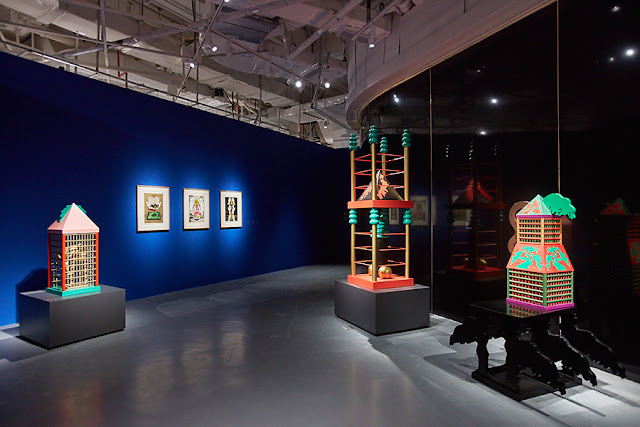John Alcorn (February 10, 1935 – January 27, 1992) was an American commercial artist and designer, and an illustrator of children's books. In addition to his accomplishments in the areas of packaging, corporate and dimensional design, Alcorn designed the opening titles for several Federico Fellini films. During his career, Alcorn created numerous book jackets and paperback covers, and his work appeared in many major exhibits.
A native New Yorker, John Alcorn was born in Corona, Queens, in 1935. When he was five years old, his family moved to Great Neck, Long Island. He was educated in the local schools. He studied graphic arts at The Cooper Union. During his first two years at Cooper Union, he studied drawing, calligraphy, architecture, the mechanics of typography, and dimensional design. In his last year his studies consisted of illustration, graphics and advertising design.
Alcorn's early career included work in the art department of Esquire magazine, a brief stint with a pharmaceutical advertising agency, and sound training at the Push Pin Studios, the celebrated design studio founded by Milton Glaser, Seymour Chwast, Reynold Ruffins, and Edward Sorel. In 1958 Alcorn joined CBS Radio and subsequently the CBS-TV art department, but a year later he decided to freelance exclusively. In 1962 Alcorn designed and illustrated Books! by Murray McCain, which was selected as one of the best fifty books of the year by the American Institute of Graphic Arts. Besides book illustrations, Alcorn designed numerous paperback covers, jackets, and promotion materials.
Following graduation from Cooper Union, Alcorn married and in 1962 settled in Ossining, New York, where he lived with his wife Phyllis, and their four sons. In 1971 he moved with his family to Florence, Italy. In 1977 he returned with his family to the United States, settling in Cold Spring, New York. In 1983 Alcorn and his wife moved to Hamburg Cove in Lyme, Connecticut.
Exhibitions and collections
Alcorn's work has been exhibited at the Louvre in Paris, the Castello Sforzesco in Milan, and the Venice Biennale. It was included in the Push Pin Studios Retrospective Show at the Louvre, in March 1970. Alcorn's works are included in the Kerlan Collection at the University of Minnesota.
Awards
Alcorn received awards from the New York Art Directors Club, the Society of Illustrators, and Cooper Union. In 1968 he won first prize at the Bologna Children's Book Fair. He was the recipient of the prestigious Augustus Saint-Gaudens Medal from Cooper Union. In 1970, he was selected as the first graphic artist to be Artist-In-Residence at Dartmouth College. In 1987 he was Artist-In-Residence at the Maryland Institute College of Art. Other awards include:
New York Times choice of Best Illustrated Children's Books of the Year
1962 for Books!
1966, for Wonderful Time
Fifty Books of the Year, American Institute of Graphic Arts, 1963, for Books!
first prize Bologna Children's Book Fair, 1968
Augustus St. Gaudens Medal, The Cooper Union, 1970
Illustration work
Books illustrated by Alcorn are all for children, except as indicated.
Murray McCain, Books! (nonfiction), J. Cape, 1962
Al Hine, Where in the World Do You Live? (fiction), Harcourt, 1962
Mary Kay Phelan, The Circus, Holt, 1963
Ogden Nash, Everyone but Thee and Me (adult poems), Dent, 1963
Hine, Money Round the World, Harcourt, 1963
Stella Standard, The Art of Fruit Cookery, Doubleday, 1964
Sesyle Joslin, The Petite Famille (French language reader), Harcourt, 1964
Television Note Book: 1964, Columbia Broadcasting System, Inc., 1964
McCain, Writing! (nonfiction), Ariel, 1964. Hine, A Letter to Anywhere (nonfiction), Harcourt, 1964
Marie Winn and Alan Miller, The Fireside Book of Children's Songs, Simon & Schuster, 1966
Phyllis McGinley, Wonderful Time (poems), Lippincott, 1966
Joslin, La Fiesta (Spanish language reader), Harcourt, 1967
Jan Wahl, Pocahontas in London (fiction), Delacorte, 1967
Martin Gardner, Never Make Fun of a Turtle, My Son (poems), Simon & Schuster, 1969
One, Two, Three, Hallmark, 1970
The Great Book of Puzzles and Perplexities, 1978
He also illustrated and designed numerous book jackets and paperback covers, two print catalogs, and contributed illustrations to many periodicals, including McCall's, Playboy, and Sports Illustrated.
References
Biography by Stephen Alcorn
American Artist (Sept. 1958)
Graphis (Nov. 1958), Vol. 27, 1971–72
Newsweek (June 10, 1963)
Publishers Weekly (June 1, 1964)
Lee Kingman and others compilers, Illustrators of Children's Books, 1957-1966 (Horn Books, 1968)
Doris de Montrville and Donna Hill, editors, Third Book of Junior Authors (H. W. Wilson, 1972)































